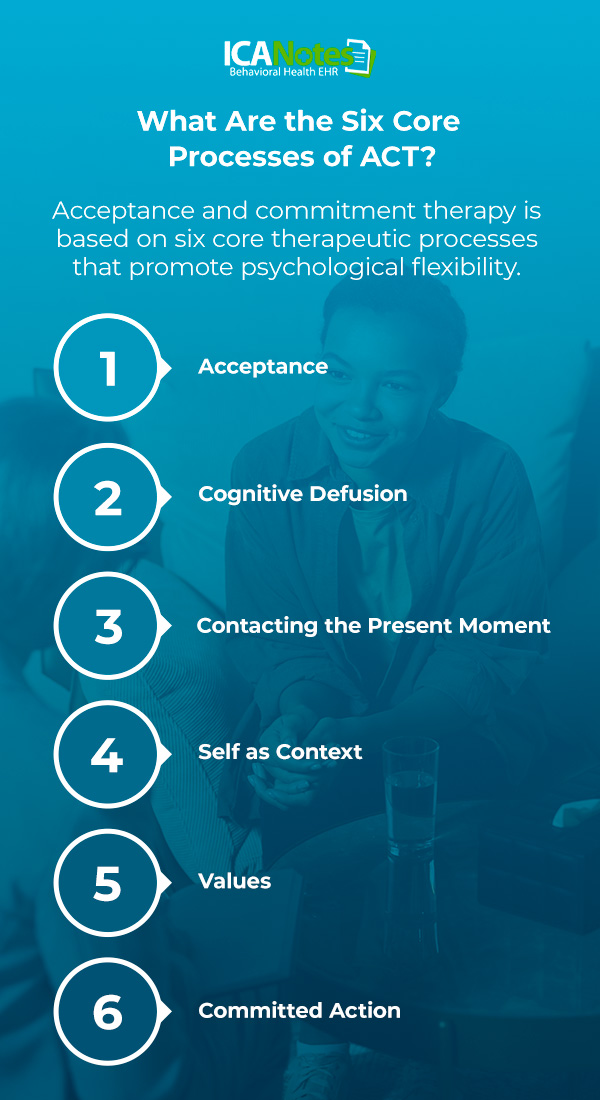
What Is Acceptance and Commitment Therapy (ACT)?
Patients who experience anxiety, depression or emotional distress often try to avoid painful feelings or experiences. Though this is sometimes a knee-jerk reaction, distressing experiences and negative emotions are a part of life. As a psychologist, counselor or other mental health professional, you can use Acceptance and Commitment Therapy (ACT) intervention to help your clients accept the reality of their experiences and modify their behaviors to live a more productive, meaningful life.
Using a combination of mindfulness and behavioral change techniques, your patients may be able to achieve better mental well-being. In this guide, we'll examine what acceptance and commitment therapy is, how it compares to other therapeutic approaches and how you can use it in your practice.
FREE Download: Acceptance and Commitment Therapy Worksheets

Introduction to ACT Therapy for Mental Health Professionals
ACT was developed and founded by Dr. Steven C. Hayes over two decades ago. This technique was partly inspired by his own history of panic attacks and the desire to accept himself and his experience. His goal was to improve psychological flexibility through mindful practices and acceptance of negative emotions and experiences. Dr. Hayes used the relational frame theory (RFT) as a theoretical foundation for ACT, which focuses on the connections between cognition and the human language.
RFT, also known as framing, is a modern technique derived from behavior analysis that refers to how people create connections between concepts using words. RFT can be used as an approach to alter functional patterns of relational framing, which requires learning how new relations emerge in the absence of direct reinforcement.
When connecting RFT to ACT, the transformation of stimulus function is essential. For instance, suppose you are treating a client with anxiety. You might suggest that they should set a goal to attend one social event, resulting in them becoming avoidant or defensive. In that case, the verbal stimulus of a “social event” could trigger an avoidance or defensive function.
The goal of ACT as a treatment method is to enhance an individual's ability to actively overcome such unwanted or painful emotions by being more aware of and fully connected to their own abilities. Additionally, ACT emphasizes modifying behaviors to help individuals:
- Achieve established goals.
- Accept unwanted experiences.
- Understand their reactions to unwanted thinking.
- Establish value-driven behavior change.
Research Insights: The Efficacy of ACT in Treating Various Conditions
ACT has been proven to effectively manage symptoms and treat a range of conditions, including:
- Depression
- Mixed anxiety
- Obsessive-compulsive disorder (OCD)
- Eating disorders
- Substance abuse
- Chronic pain
- Occupational stress
- Psychosis
- Autism spectrum disorder (ASD)
Individuals with OCD experienced a 40% decrease in symptoms after just eight sessions of ACT. These sessions also significantly reduced distress caused by obsessive thoughts and the severity of symptoms.
Patients with social anxiety can also benefit from ACT interventions. In fact, ACT is more effective for treating social anxiety than group cognitive therapy. This research further revealed that ACT is also more effective at treating depression than cognitive therapy. Other studies indicate that the quality of life in patients who receive ACT treatment significantly improves.
Though the primary goal of ACT is improving a patient's ability to live a self-determined life, symptom reduction is a by-product of enhanced psychological flexibility. In some cases, ACT has addressed and managed chronic disease symptoms.
In a study comprised of 20 adults with autism spectrum disorder, researchers noted the following clinical improvements as a result of ACT:
- Autistic mannerism
- Perceived stress and quality of life
- Cognitive and behavioral avoidance
- Cognitive fusion
- Psychological flexibility
These studies support the effectiveness of ACT as a psychological intervention to address various mental health conditions as well as high perceived stress, reduced quality of life and overcoming obstructive thoughts and managing difficult emotions.
Acceptance and Commitment Therapy Principles and Techniques
Using ACT as a method for integrated care for a variety of mental health interventions can help your clients achieve better outcomes. To better understand how ACT works, we've outlined exactly how this type of therapy addresses psychopathology conditions.
What Are the Six Core Processes of ACT?
Acceptance and commitment therapy is based on six core therapeutic processes that promote psychological flexibility.
1. Acceptance
Clients learn to accept negative feelings even though they have no control over them. They open themselves up to make room for unpleasant thoughts, experiences and emotions. Instead of trying to avoid or deny these events, they acknowledge them and break the vicious cycle of worrying.
2. Cognitive Defusion
The concept of defusion refers to learning how to step back from one's thoughts and change the way one reacts to distressing feelings and thoughts. Clients learn how to lessen the emotional impact of their thoughts to mitigate their harmful effects.
3. Contacting the Present Moment
An important component of ACT is practicing mindfulness and focusing on the "now" rather than on the past. This principle helps clients use all five of their senses to bring themselves into the present moment and establish skills to ignore distracting thoughts.
4. Self as Context
Also called the Observing Self, this core process of ACT refers to the concept of distancing oneself from thoughts, sensations, images and memories. This technique enables clients to take a step back and become observers of themselves to understand that they are more than their thoughts. From an outside perspective, negative emotions and experiences may not feel as dangerous or threatening.

5. Values
Also called value living, this core process describes what an individual cares most about in their lives. Defining personal values can help clients modify their behaviors toward more meaningful outcomes instead of actions that avoid distress or aim to meet other people's expectations. By focusing on what they want to be, your clients may be more willing to experience some anxiety as they welcome the natural stressors that come with behavior adjustments.
6. Committed Action
An important aspect of any therapeutic intervention is taking effective action toward one's goals. Committed action refers to outlining concrete steps that will bring positive change in an individual's life, such as skill development, goal setting and exposure to difficult thoughts or experiences.
A Deeper Look at the Interconnected Therapeutic Framework
These six principles come together to form a comprehensive framework that addresses basic human needs. With the overlapping principles of ACT, individuals learn to accept their perceived flaws while increasing mental flexibility against future challenges they may experience.
These building blocks of ACT aim to facilitate behavioral change by helping individuals outline and plan effective and realistic behaviors that meet their values. When an individual ignores their long-term values, their quality of life can suffer. This can lead to poor physical and mental health outcomes, such as denial about behavioral risks, medication nonadherence and delaying preventive health care.
Implementation of ACT can improve your client's willingness to experience and accept unpleasant Thoughts, Emotions, Associations, Memories and Sensations (TEAMS). Accepting the negative aspects of life can help them engage in healthier and more meaningful behaviors.
In addition to these six core processes, there are also four properties of psychological flexibility:
- Recognizing and adapting to situational demands
- Shifting perspective when functioning is compromised
- Balancing competing life demands
- Being aware and committed to behaviors that align with personal values
5 Acceptance and Commitment Therapy Exercises and Techniques
Though every individual has different needs and goals, here are some examples of exercises you can build on during your ACT therapy sessions with your clients.
1. Ranking Values
Have your client perform a value clarification exercise. Ranking their values by priorities will help you both identify in what areas of their lives they feel unfilled or need further development. Instruct your client to rate each life domain according to importance, such as family, finances, relationships or self-care. Next, find their top three value priorities and set goals for meeting them.
2. Anchor Breathing
A key exercise for improving mindfulness is focusing on one's breathing, such as during meditation. When your client feels stressed, instruct them to ground themselves through mindful breathing. In an anchor breathing exercise, they will envision themselves feeling safe and calm in a boat anchored in a place that keeps them happy. Now, tell them to imagine themselves as the anchor, using their body to feel grounded. As they breathe, remind them to bring themselves back to the anchor point if their mind wanders.

3. Defusion Questions
It's common for people with anxiety or OCD to have difficulties identifying negative thought patterns as they occur. Using this defusion exercise, instruct your patient to answer questions that can help strengthen their mindfulness skills. These questions might include “Is this thought helpful?” “What do I gain by buying into this thought?” “Am I going to trust my mind babbling on or my experience?” or “Is this thought going to help me reach my goals?”
4. Write a Future Birthday Speech
A sentimental exercise can help put things into perspective for some clients. Ask your client to imagine that it's their 90th birthday and describe what their dearest friend or significant other would say about their life. What would they like to hear about themselves? What kind of person do they want to be remembered as?
5. Thank Your Mind
When people experience anxiety or stress, their minds tend to amplify it in the form of negative self-talk or thoughts. This exercise involves telling your client to “thank” their mind when a judgmental or self-defeating thought appears, acknowledge it and let it go. For example, if “I'm not good enough” pops into their head, they can thank their mind for the replay of that storyline and let it fade into the background. You can also provide self-esteem worksheets that help your clients build self-compassion and confidence.
Role of Therapists in ACT Outcomes

As a therapist or counselor, your guidance can make all the difference in your client's journey toward mental well-being. The main goal of ACT is to increase psychological flexibility, and practitioners can facilitate this by helping patients be more mindful of the ways they feel and think using various mindfulness exercises.
You want your patients to create lasting behavioral changes, which means committing to new thought patterns, actions and behaviors. Working with your patients to help them learn to accept their TEAMS and evaluating what elements are no longer serving their life goals can promote more positive thoughts and actions.
Your role as a therapist in ACT implementation strategies may also include helping patients:
- Work through painful memories.
- Determine what things they can or cannot change.
- Make peace with the things they cannot control.
- Develop strategies for making necessary changes to meet personal goals.
- Evaluate patterns that have a negative impact on their lives.
- Acknowledge their emotions.
- Learn how to experience discomfort without trying to avoid it.
- Identify interventions that fit their individual needs.
- Address common obstacles as they appear.
- Measure and track their progress.
ACT vs. CBT and DBT: Comparing Therapy Approaches for Therapists and Counselors
There are countless effective interventions that you can use in your practice to address conditions like anxiety, depression and OCD. Let's examine how ACT compares to traditional therapy methods like cognitive behavioral therapy (CBT) and dialectal behavior therapy (DBT).
Cognitive Behavioral Therapy (CBT)
ACT and CBT are relatively similar because they both aim to help individuals overcome difficult thoughts and feelings. However, CBT generally focuses on reframing harmful thought patterns, while ACT prioritizes accepting them. The primary goal of CBT is to reduce symptoms, whereas the goal of ACT is to strengthen psychological flexibility.
You may prefer to implement CBT if you want your client to identify and modify negative or destructive thoughts. Alternatively, ACT may be ideal for patients who could benefit from accepting the good and the bad that come with life rather than trying to change them. Finally, ACT is usually a long-term treatment option that clients integrate into their daily lives over time. CBT tends to be more goal-oriented for specific issues.
Dialectical Behavior Therapy (DBT)
ACT and DBT both focus on the importance of acceptance, mindfulness and effectiveness of action. They both are effective psychotherapy methods that aim to help individuals gain control over their thoughts and improve their quality of life. DBT and ACT also help patients face their undesirable or uncomfortable feelings head-on to promote psychological flexibility. However, their underlying theories are quite different. While ACT emphasizes observation and experience to help individuals cope with their conditions, DBT leans more toward an educational approach.
For example, DBT interventions may involve developing logical, hands-on skills and strategies that patients can use in their daily lives. Finally, ACT is generally considered to have a functional contextualism philosophy, whereas DBT maintains a dialectical and analytical philosophy. It's important to note that there are certainly benefits and challenges of each approach depending on your client's needs, symptoms and history of mental health treatment.
Explore ICANotes for Solutions That Support ACT Documentation
A dedicated behavioral health professional like you is always looking for new schools of thought and applications to best support your patient's needs. Between writing manual clinical documentation and meeting tedious regulations, it can be challenging to have enough time to implement new intervention techniques. With ICANotes, you can focus on improving mental health outcomes without spending hours on your documentation.
ICANotes is the premier EHR for behavioral health specialty, providing clinicians like you with a robust charting solution so you can effectively monitor patient progress and tailor treatment plans to their unique needs. Our platform provides a wide range of assessment tools, progress notes and ACT documentation resources so you can provide integrated care to bridge gaps across your practice. To learn more about how our EHR solution can benefit your workflow, schedule a demo online or start your free trial today.
Start Your Free Trial Today

